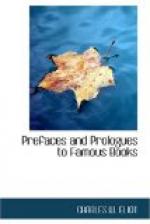We shall fail entirely to understand, but again—very good. You imagine that this is all? By no means: before the tenth sentence in Castilian, he is certain to rise and ask if the Cid who is speaking is the real Cid, in flesh and blood. By what right does the actor, whose name is Pierre or Jacques, take the name of the Cid? That is false. There is no reason why he should not go on to demand that the sun should be substituted for the footlights, real trees and real houses for those deceitful wings. For, once started on that road, logic has you by the collar, and you cannot stop.
We must admit, therefore, or confess ourselves ridiculous, that the domains of art and of nature are entirely distinct. Nature and art are two things—were it not so, one or the other would not exist. Art, in addition to its idealistic side, has a terrestrial, material side. Let it do what it will, it is shut in between grammar and prosody, between Vaugelas and Richelet. For its most capricious creations, it has formulas, methods of execution, a complete apparatus to set in motion. For genius there are delicate instruments, for mediocrity, tools.
It seems to us that someone has already said that the drama is a mirror wherein nature is reflected. But if it be an ordinary mirror, a smooth and polished surface, it will give only a dull image of objects, with no relief-faithful, but colourless; everyone knows that colour and light are lost in a simple reflection. The drama, therefore, must be a concentrating mirror, which, instead of weakening, concentrates and condenses the coloured rays, which makes of a mere gleam a light, and of a light a flame. Then only is the drama acknowledged by art.
The stage is an optical point. Everything that exists in the world—in history, in life, in man—should be and can be reflected therein, but under the magic wand of art. Art turns the leaves of the ages, of nature, studies chronicles, strives to reproduce actual facts (especially in respect to manners and peculiarities, which are much less exposed to doubt and contradiction than are concrete facts), restores what the chroniclers have lopped off, harmonises what they have collected, divines and supplies their omissions, fills their gaps with imaginary scenes which have the colour of the time, groups what they have left scattered about, sets in motion anew the threads of Providence which work the human marionettes, clothes the whole with a form at once poetical and natural, and imparts to it that vitality of truth and brilliancy which gives birth to illusion, that prestige of reality which arouses the enthusiasm of the spectator, and of the poet first of all, for the poet is sincere. Thus the aim of art is almost divine: to bring to life again if it is writing history, to create if it is writing poetry.




